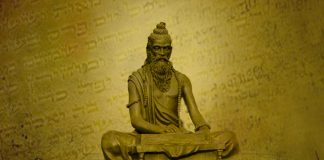“Ashta” + “Tanga” combine to form the word Ashtanga in Sanskrit language. Ashta means eight and Tanga means limbs. The literal transalation is Eight Limb Path for Yoga. Sage Patanjali was the author of the Yoga Sutras which contains wisdom and technique of Ashtanga Yoga.
Yoga is essentially the union of the body and the mind. This eight-fold method was explained by Patanjali for spiritual seekers on the path of self-realization.
Steps for Ashtanga Yoga:
Yama: – Beginners on the path of yoga have to follow certain set of ethics, so they are in harmony with their community and the society they live in. These are
- Ahimsa: – Non-violence
- Satya: – Think and speak the truth
- Asteya:-Non-covetousness
- Brahmacharya:- Practice of moderation and abstinence
- Aparigraha:-Non-possessiveness
Niyama:- After yama has been practiced to purify the Mind and body, niyama is required to ensure that the purity of the mind and body is not corrupted again. These are
- Saucha:- Cleanliness of body and mind
- Santosha:-Satisfaction
- Tapas:- Disciplining the body and the mind
- Svadhyaya:- studying the Scriptures and reflecting on the wisdom
- Ishvara Pranidhana:- Surrender to God
Asanas:- These postures aid in keeping the body healthy and flexible. If our body is free from disease and discomfort, then it becomes a channel for pursuing the path of yoga. Otherwise, a weak ailing body will become an obstacle, and distract us from our spiritual aspirations. Negative stress and emotions are released as we practice these Asanas and lead to physical as well as mental wellbeing.
Pranayama:- Once e we gain mastery over the body, we use the control of breath to Stabilize the mind. One follows the movement of breath to calm an agitated mind. This method of watching and controlling of breath enables us to focus and control our minds.
Pratyahara:- From this step, our endeavor is to turn inwards. Withdrawal of the senses is practiced to keep our concentration and focus. External influences should not distract us. Closing our eyes is a great example to shut off our visual senses. Thus, in most yogic postures shutting our eyes helps to focus on the breath and improve our posture. Commercial yoga lessons use classical background music to get people in the mood for yoga. True spiritual seekers focus their attention inwards. To deepen their awareness they shut their eyes, turn off the music and practice yoga with the deep breathing method. “Indriyas” the organs of senses come under our will and control. We use our will power to overcome temptations of the sense organs.
Dharana:- Fixing our attention to the center of the forehead or the heart, helps us in meditation. This a method to increase our level of concentration to one point or to one place. The concept is to focus our attention to that area, while we watch our breath rise and fall. We are only aware of the rhythmic waves in that spot. The mental waves in other areas diminish as our awareness is pronounced only in the particular spot.
Dhyana:- Once we are able to train the mind to focus on a certain point, we have mastered the technique of conscious effort to exclude thoughts, emotions which are not needed for that object of concentration. The Sanskrit word for meditation is Dhyana, moving the mind towards the Supreme Consciousness.
Samadhi:- This is the state of Oneness, when we merge with the object of concentration. The goal of yoga is to merge the soul with the cosmic soul. This is also called Bliss or Enlightenment. We are able to look at everything with no bias or judgement. This is the final limb of yoga.
Patanjali has placed the principles of Yama and Niyama before the Asanas as the purification of the body and mind is very essential, before we start focusing on the postures. In the modern world, the term Yoga is only associated with flexibility and deep breathing. Most yoga enthusiasts are not really able to deepen their awareness with a daily yoga routine. The essence of the purity of body and mind is lost in just focusing on practicing the physical postures and correcting the mistakes . On the brighter side, asanas are a good way to encourage people to keep their bodies healthy. As the yoga beginners dig deep into the union of mind and body, there is a strong possibility that they may stumble upon the eight limbs, and enjoy the fragrance of the true spirit of Ashtanga Yoga.
Patanjali has shared this wisdom to connect with our inner self and enrich our experience. Once we discover the treasure of the Ashtanga Yoga, we understand how Yoga strengthens the power of the mind with a healthy, flexible body.
To reach the state of Samadhi is an individual journey depending on their Sadhana. The word “Sadhana” is another word for practice. Nothing comes without sweat or grime in the commercial world. Likewise, we need to invest time to practice the eight steps of Ashtanga Yoga with a sincere heart. Sage Patanjali has explained the path by breaking it into small eight steps. Our “Sadhana” is our commitment, which will put us on the path to uncover this ancient treasure. Let’s take the first step!
47 Most Famous Motivational Quotes of All-Time
49 Greatest Love Quotes
37 Inspirational Quotes that Will Change Your Life
































